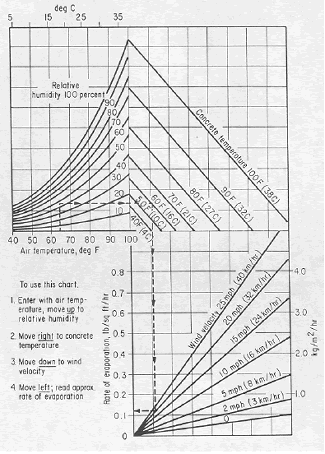U.S. Department of Transportation
Federal Highway Administration
1200 New Jersey Avenue, SE
Washington, DC 20590
202-366-4000
Federal Highway Administration Research and Technology
Coordinating, Developing, and Delivering Highway Transportation Innovations
 |
| This report is an archived publication and may contain dated technical, contact, and link information |
|
Publication Number: FHWA-HRT-04-150 Date: July 2006 |
Previous | Table of Contents | Next
Plastic shrinkage cracks occur when the rate of evaporation from the surface of the HCC exceeds the rate of bleeding (see ACI 224R). Bleeding is a process whereby the solids of the HCC, including the cement and other fine particles, settle and water rises to the top. (The process is thought to be a form of syneresis by some.) The bleed water forms a "sheen"on the top of the HCC. When the process proceeds as it should, water is evenly distributed throughout the thickness of the HCC placement. The water sheen on the surface prevents the top portion of the HCC from becoming drier than the bottom portion (i.e., the water on the surface maintains 100-percent humidity throughout the concrete). The condition of 100-percent humidity is required so that there will be sufficient water for the remainder of the hydration to take place and so that the HCC will fill the space appropriately and not shrink.
When the proper humidity is not maintained, the top portion of the HCC becomes drier than the lower portions of the HCC, and shrinkage (loss of volume) occurs within the drier portion. When HCC shrinks, it can no longer fill the space it occupies. The lower portion (where there is 100-percent humidity) does not shrink and, therefore, the entire body does not change size. The drier top (the smaller portion) cracks to accommodate the shrinkage, but remains attached to the larger bottom portion.
When plastic shrinkage cracking of any great extent is observed, careful inquiry into the inspector’s records and the observations of others who were near the placement will almost always indicate that one or more of the following occurred:
Figure 205. Effect of concrete temperature, air temperature, wind velocity, and relative humidity on the rate of evaporation of surface moisture from a concrete surface.

If the rate of evaporation approaches the danger point for the concrete being used, precautions against plastic shrinkage cracking are necessary (ACI Manual of Concrete Practice (updated yearly)).
When finishing is completed and the sheen disappears by evaporation of the surface bleed water, curing procedures must begin promptly. At this point, there is no layer of water to protect the HCC from drying or to maintain the 100-percent humidity within the HCC. If there is a wind blowing, the humidity is low, the ambient temperature is high, or the temperature of the HCC is high, the rate of evaporation will be especially rapid. Promptness is the essence of efficient curing. Figure 204 shows how all of these conditions combine to contribute to the rate of evaporation.
For ordinary bridge deck concrete, the rate of evaporation should not exceed 0.5 kilograms per square meter per hour (kg/m2/h). For latex-modified concrete overlays and other cement concrete with a w/cm less than 0.40, the maximum evaporation rate must not exceed 0.25 kg/m2/h (Kuhlman, 1991).
The curing procedures must be maintained properly. When climatic conditions are very unfavorable, it may be necessary to raise the humidity by misting the air over the concrete, erecting wind breaks or sunshades, or limiting the placement of HCC to cooler nighttime hours. The moisture must be maintained in the HCC throughout the curing period. It will be necessary to remoisten any curing cover (such as burlap) periodically
The client or an adversarial witness in a court proceeding may wish to inquire concerning the following:
American Concrete Institute. ACI 224R: Control of Cracking in Concrete Structures, ACI Manual of Concrete Practice: Part 2, Construction Practices and Inspection. Farmington Hills, MI.
American Concrete Institute.ACI Manual of Concrete Practice, Volumes1–5 (revised yearly).Farmington Hills, MI.
Kuhlman, L.A. 1991. "Cracks in LMC Overlays: How Do They Get There?, How Serious Are They?, What to Do About Them?," Transportation Research Record No. 1301. Transportation Research Board, Washington, DC, pp. 17–21.